Michael Niemeyer
GALA: Guided Attention with Language Alignment for Open Vocabulary Gaussian Splatting
Aug 21, 2025Abstract:3D scene reconstruction and understanding have gained increasing popularity, yet existing methods still struggle to capture fine-grained, language-aware 3D representations from 2D images. In this paper, we present GALA, a novel framework for open-vocabulary 3D scene understanding with 3D Gaussian Splatting (3DGS). GALA distills a scene-specific 3D instance feature field via self-supervised contrastive learning. To extend to generalized language feature fields, we introduce the core contribution of GALA, a cross-attention module with two learnable codebooks that encode view-independent semantic embeddings. This design not only ensures intra-instance feature similarity but also supports seamless 2D and 3D open-vocabulary queries. It reduces memory consumption by avoiding per-Gaussian high-dimensional feature learning. Extensive experiments on real-world datasets demonstrate GALA's remarkable open-vocabulary performance on both 2D and 3D.
Masks make discriminative models great again!
Jul 01, 2025Abstract:We present Image2GS, a novel approach that addresses the challenging problem of reconstructing photorealistic 3D scenes from a single image by focusing specifically on the image-to-3D lifting component of the reconstruction process. By decoupling the lifting problem (converting an image to a 3D model representing what is visible) from the completion problem (hallucinating content not present in the input), we create a more deterministic task suitable for discriminative models. Our method employs visibility masks derived from optimized 3D Gaussian splats to exclude areas not visible from the source view during training. This masked training strategy significantly improves reconstruction quality in visible regions compared to strong baselines. Notably, despite being trained only on masked regions, Image2GS remains competitive with state-of-the-art discriminative models trained on full target images when evaluated on complete scenes. Our findings highlight the fundamental struggle discriminative models face when fitting unseen regions and demonstrate the advantages of addressing image-to-3D lifting as a distinct problem with specialized techniques.
LODGE: Level-of-Detail Large-Scale Gaussian Splatting with Efficient Rendering
May 29, 2025Abstract:In this work, we present a novel level-of-detail (LOD) method for 3D Gaussian Splatting that enables real-time rendering of large-scale scenes on memory-constrained devices. Our approach introduces a hierarchical LOD representation that iteratively selects optimal subsets of Gaussians based on camera distance, thus largely reducing both rendering time and GPU memory usage. We construct each LOD level by applying a depth-aware 3D smoothing filter, followed by importance-based pruning and fine-tuning to maintain visual fidelity. To further reduce memory overhead, we partition the scene into spatial chunks and dynamically load only relevant Gaussians during rendering, employing an opacity-blending mechanism to avoid visual artifacts at chunk boundaries. Our method achieves state-of-the-art performance on both outdoor (Hierarchical 3DGS) and indoor (Zip-NeRF) datasets, delivering high-quality renderings with reduced latency and memory requirements.
SplatVoxel: History-Aware Novel View Streaming without Temporal Training
Mar 18, 2025Abstract:We study the problem of novel view streaming from sparse-view videos, which aims to generate a continuous sequence of high-quality, temporally consistent novel views as new input frames arrive. However, existing novel view synthesis methods struggle with temporal coherence and visual fidelity, leading to flickering and inconsistency. To address these challenges, we introduce history-awareness, leveraging previous frames to reconstruct the scene and improve quality and stability. We propose a hybrid splat-voxel feed-forward scene reconstruction approach that combines Gaussian Splatting to propagate information over time, with a hierarchical voxel grid for temporal fusion. Gaussian primitives are efficiently warped over time using a motion graph that extends 2D tracking models to 3D motion, while a sparse voxel transformer integrates new temporal observations in an error-aware manner. Crucially, our method does not require training on multi-view video datasets, which are currently limited in size and diversity, and can be directly applied to sparse-view video streams in a history-aware manner at inference time. Our approach achieves state-of-the-art performance in both static and streaming scene reconstruction, effectively reducing temporal artifacts and visual artifacts while running at interactive rates (15 fps with 350ms delay) on a single H100 GPU. Project Page: https://19reborn.github.io/SplatVoxel/
SuperGSeg: Open-Vocabulary 3D Segmentation with Structured Super-Gaussians
Dec 13, 2024



Abstract:3D Gaussian Splatting has recently gained traction for its efficient training and real-time rendering. While the vanilla Gaussian Splatting representation is mainly designed for view synthesis, more recent works investigated how to extend it with scene understanding and language features. However, existing methods lack a detailed comprehension of scenes, limiting their ability to segment and interpret complex structures. To this end, We introduce SuperGSeg, a novel approach that fosters cohesive, context-aware scene representation by disentangling segmentation and language field distillation. SuperGSeg first employs neural Gaussians to learn instance and hierarchical segmentation features from multi-view images with the aid of off-the-shelf 2D masks. These features are then leveraged to create a sparse set of what we call Super-Gaussians. Super-Gaussians facilitate the distillation of 2D language features into 3D space. Through Super-Gaussians, our method enables high-dimensional language feature rendering without extreme increases in GPU memory. Extensive experiments demonstrate that SuperGSeg outperforms prior works on both open-vocabulary object localization and semantic segmentation tasks.
Gaussians-to-Life: Text-Driven Animation of 3D Gaussian Splatting Scenes
Nov 28, 2024
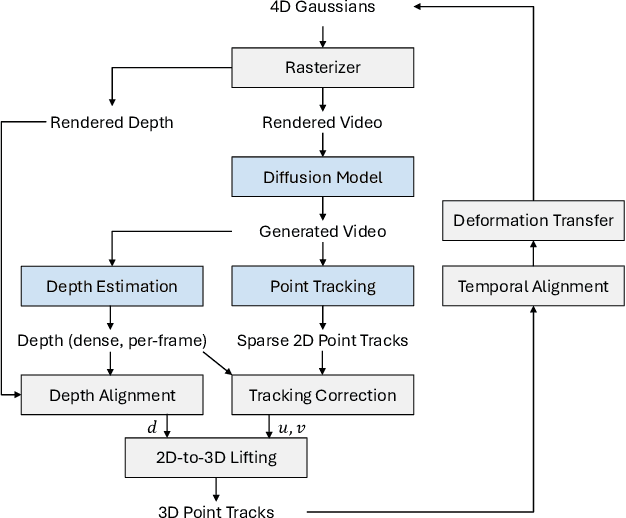
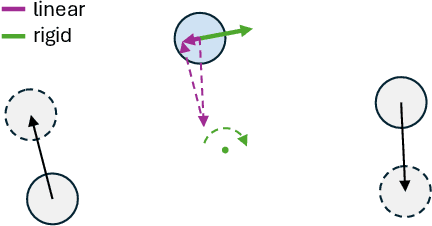
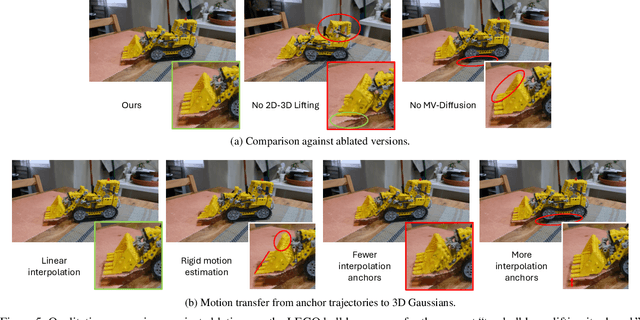
Abstract:State-of-the-art novel view synthesis methods achieve impressive results for multi-view captures of static 3D scenes. However, the reconstructed scenes still lack "liveliness," a key component for creating engaging 3D experiences. Recently, novel video diffusion models generate realistic videos with complex motion and enable animations of 2D images, however they cannot naively be used to animate 3D scenes as they lack multi-view consistency. To breathe life into the static world, we propose Gaussians2Life, a method for animating parts of high-quality 3D scenes in a Gaussian Splatting representation. Our key idea is to leverage powerful video diffusion models as the generative component of our model and to combine these with a robust technique to lift 2D videos into meaningful 3D motion. We find that, in contrast to prior work, this enables realistic animations of complex, pre-existing 3D scenes and further enables the animation of a large variety of object classes, while related work is mostly focused on prior-based character animation, or single 3D objects. Our model enables the creation of consistent, immersive 3D experiences for arbitrary scenes.
G2SDF: Surface Reconstruction from Explicit Gaussians with Implicit SDFs
Nov 25, 2024Abstract:State-of-the-art novel view synthesis methods such as 3D Gaussian Splatting (3DGS) achieve remarkable visual quality. While 3DGS and its variants can be rendered efficiently using rasterization, many tasks require access to the underlying 3D surface, which remains challenging to extract due to the sparse and explicit nature of this representation. In this paper, we introduce G2SDF, a novel approach that addresses this limitation by integrating a neural implicit Signed Distance Field (SDF) into the Gaussian Splatting framework. Our method links the opacity values of Gaussians with their distances to the surface, ensuring a closer alignment of Gaussians with the scene surface. To extend this approach to unbounded scenes at varying scales, we propose a normalization function that maps any range to a fixed interval. To further enhance reconstruction quality, we leverage an off-the-shelf depth estimator as pseudo ground truth during Gaussian Splatting optimization. By establishing a differentiable connection between the explicit Gaussians and the implicit SDF, our approach enables high-quality surface reconstruction and rendering. Experimental results on several real-world datasets demonstrate that G2SDF achieves superior reconstruction quality than prior works while maintaining the efficiency of 3DGS.
Evolutive Rendering Models
May 27, 2024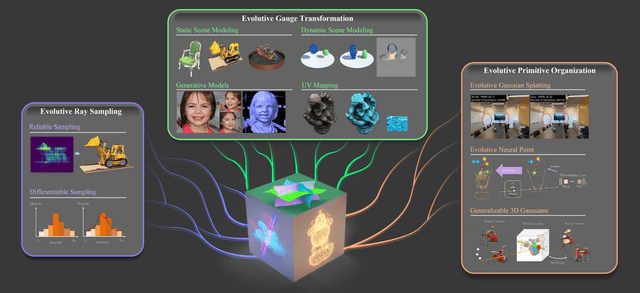
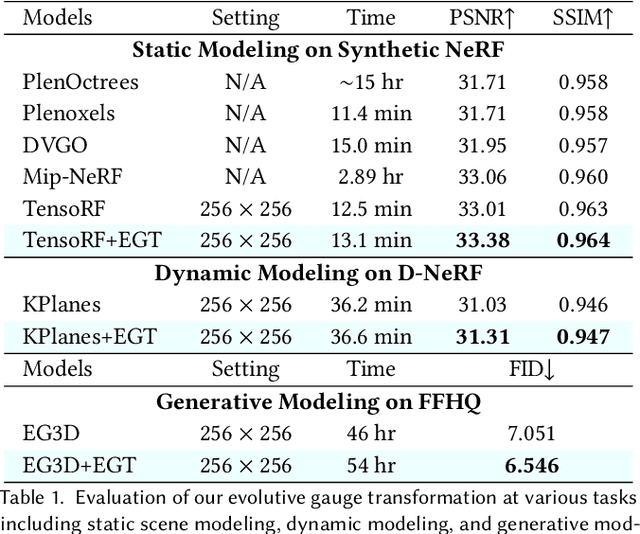
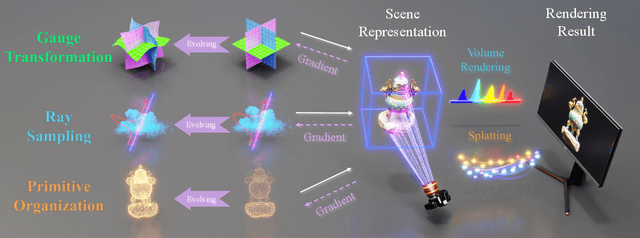

Abstract:The landscape of computer graphics has undergone significant transformations with the recent advances of differentiable rendering models. These rendering models often rely on heuristic designs that may not fully align with the final rendering objectives. We address this gap by pioneering \textit{evolutive rendering models}, a methodology where rendering models possess the ability to evolve and adapt dynamically throughout the rendering process. In particular, we present a comprehensive learning framework that enables the optimization of three principal rendering elements, including the gauge transformations, the ray sampling mechanisms, and the primitive organization. Central to this framework is the development of differentiable versions of these rendering elements, allowing for effective gradient backpropagation from the final rendering objectives. A detailed analysis of gradient characteristics is performed to facilitate a stable and goal-oriented elements evolution. Our extensive experiments demonstrate the large potential of evolutive rendering models for enhancing the rendering performance across various domains, including static and dynamic scene representations, generative modeling, and texture mapping.
Splat-SLAM: Globally Optimized RGB-only SLAM with 3D Gaussians
May 26, 2024



Abstract:3D Gaussian Splatting has emerged as a powerful representation of geometry and appearance for RGB-only dense Simultaneous Localization and Mapping (SLAM), as it provides a compact dense map representation while enabling efficient and high-quality map rendering. However, existing methods show significantly worse reconstruction quality than competing methods using other 3D representations, e.g. neural points clouds, since they either do not employ global map and pose optimization or make use of monocular depth. In response, we propose the first RGB-only SLAM system with a dense 3D Gaussian map representation that utilizes all benefits of globally optimized tracking by adapting dynamically to keyframe pose and depth updates by actively deforming the 3D Gaussian map. Moreover, we find that refining the depth updates in inaccurate areas with a monocular depth estimator further improves the accuracy of the 3D reconstruction. Our experiments on the Replica, TUM-RGBD, and ScanNet datasets indicate the effectiveness of globally optimized 3D Gaussians, as the approach achieves superior or on par performance with existing RGB-only SLAM methods methods in tracking, mapping and rendering accuracy while yielding small map sizes and fast runtimes. The source code is available at https://github.com/eriksandstroem/Splat-SLAM.
OpenNeRF: Open Set 3D Neural Scene Segmentation with Pixel-Wise Features and Rendered Novel Views
Apr 04, 2024


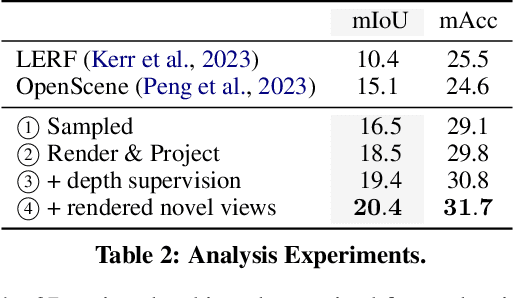
Abstract:Large visual-language models (VLMs), like CLIP, enable open-set image segmentation to segment arbitrary concepts from an image in a zero-shot manner. This goes beyond the traditional closed-set assumption, i.e., where models can only segment classes from a pre-defined training set. More recently, first works on open-set segmentation in 3D scenes have appeared in the literature. These methods are heavily influenced by closed-set 3D convolutional approaches that process point clouds or polygon meshes. However, these 3D scene representations do not align well with the image-based nature of the visual-language models. Indeed, point cloud and 3D meshes typically have a lower resolution than images and the reconstructed 3D scene geometry might not project well to the underlying 2D image sequences used to compute pixel-aligned CLIP features. To address these challenges, we propose OpenNeRF which naturally operates on posed images and directly encodes the VLM features within the NeRF. This is similar in spirit to LERF, however our work shows that using pixel-wise VLM features (instead of global CLIP features) results in an overall less complex architecture without the need for additional DINO regularization. Our OpenNeRF further leverages NeRF's ability to render novel views and extract open-set VLM features from areas that are not well observed in the initial posed images. For 3D point cloud segmentation on the Replica dataset, OpenNeRF outperforms recent open-vocabulary methods such as LERF and OpenScene by at least +4.9 mIoU.
* ICLR 2024, Project page: https://opennerf.github.io
 Add to Chrome
Add to Chrome Add to Firefox
Add to Firefox Add to Edge
Add to Edge